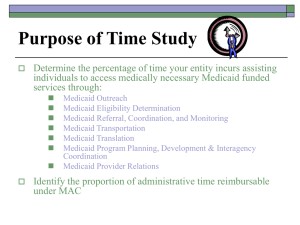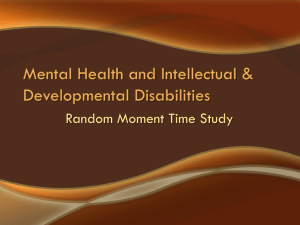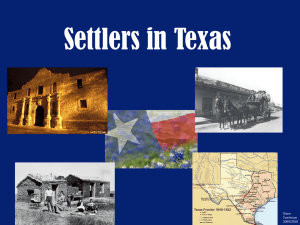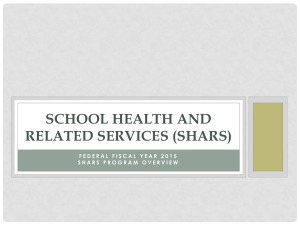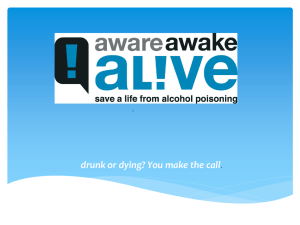Random Moment Time Study Training (RMTS)
advertisement
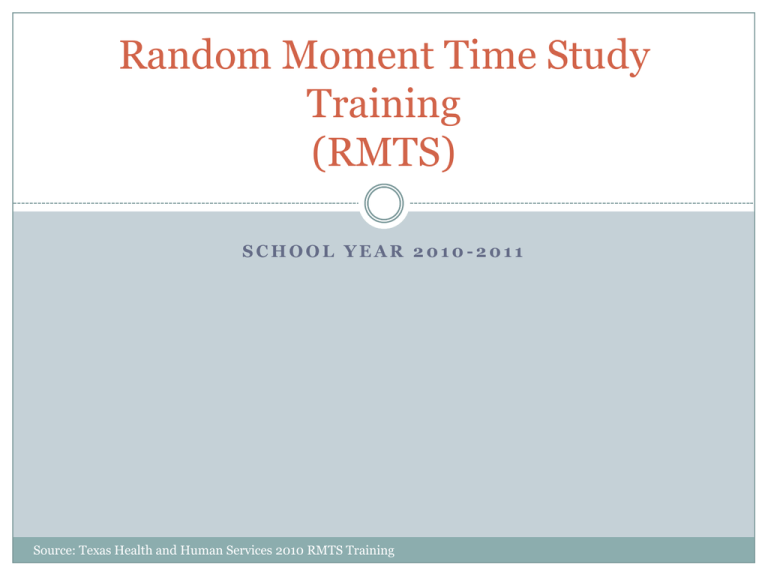
Random Moment Time Study Training (RMTS) SCHOOL YEAR 2010-2011 Source: Texas Health and Human Services 2010 RMTS Training What is RMTS? Formal Definition The RMTS results allow Health and Human Services (HHSC) to determine what portion of the selected group of participant’s workload is spent performing Medicaid reimbursable activities. Source: Texas Health and Human Services 2010 RMTS Training SHARS/MAC Programs SHARS (School Health and Related Services) SHARS allows local school districts to obtain Medicaid reimbursement for certain health-related services provided to students in special education. MAC (Medicaid Administrative Claiming) Texas School Districts [have the] opportunity to submit reimbursement claims for administrative activity that support[s] the Medicaid program. Source: Texas Health and Human Services 2010 RMTS Training Purpose of the Time Study RMTS: Measures the amount of time spent by the eligible staff on School Health and Related Services (SHARS) activities. The same data is used to measure the amount of time spent on Medicaid Administrative Claiming (MAC) activities. Determine the percentage of time the Independent School Districts incur assisting individuals to access medically necessary Medicaid funded services Source: Texas Health and Human Services 2010 RMTS Training Time Study Explained A “moment” is a specific minute in a day Randomly selected throughout each of the 3 quarters. Not necessary to know if Medicaid eligible, important to know if the student has an ARD/IEP Answer 3 questions (Never use names): Question 1. Who was with you? Question 2. What were you doing? Question 3. Why were you performing this activity? Source: Texas Health and Human Services 2010 RMTS Training Time Study Explained (cont’d) Follow-up questions from Fairbanks within 3 calendar days from email receipt If you are not at work on selected moment, choose paid or unpaid leave You must respond to your sampled moment within 7 days Source: Texas Health and Human Services 2010 RMTS Training Time Study Process Email DO NOT DELETE Source: Texas Health and Human Services 2010 RMTS Training Time Study Example Fairbanks Website Source: Texas Health and Human Services 2010 RMTS Training Time Study Example-PCS Fairbanks Website Source: Texas Health and Human Services 2010 RMTS Training Personal Care Service (PCS) Personal care services are provided to assist a child with a disability or chronic condition Personal care services include a range of human assistance provided to students to accomplish tasks the student would normally do for themselves if they did not have a disability A student may be physically capable of eating lunch but be unable to independently eat in the cafeteria because of functional, cognitive, or behavioral impairments Source: Texas Health and Human Services 2010 RMTS Training Personal Care Service (PCS) Examples Toileting Positioning Redirection for behavior Cueing Example 1: A Case Manager assists a student to transfer from their wheelchair to a couch in the library for reading time Example 2: A bilingual specialist cues a student to stop self stimulatory rocking during a social studies group assignment in an ESL classroom Example 3: An Orientation & Mobility Specialist teaches a blind student using a cane to use sounds to find their classroom Source: Texas Health and Human Services 2010 RMTS Training 1. Who was with you ? Never use specific names Student, Special Ed » (Age 0-2) » (Age 3-20) » (Age >21) Student, Special Ed, Lifeskills » (Age 0-2) » (Age 3-20) » (Age >21) Student, Not Special Ed Student (Multiple) No one alone District staff – » Administrator » Teacher » School nurse » SHARS Service Provider » Non SHARS Service Provider Source: Texas Health and Human Services 2010 RMTS Training On the phone with parent Community Contact Staff meeting Staffing » No student/family present » Student and/or family present Student's family » Non special Ed students » Special Ed student Student AND Family » Non special Ed students » Special Ed student Not Working » Paid time off » Non Paid time off Other – please specify below 2. What Were You Doing? Never use specific names Typically a 3-4 sentence description that provides sufficient information The activity description should be a detailed response, as to what the participant was doing Keep in mind that the person coding the moment has no idea of the participant’s job description, tasks performed or why they are performed If a participant was not working, the moment should indicate whether the participant was on paid/unpaid time off Source: Texas Health and Human Services 2010 RMTS Training 2. What Were You Doing? (cont’d) Never use specific names Refrain from using acronyms If necessary, further define your usage ALWAYS note whether your provided service was in IEP If you do not know, contact your diagnostician Source: Texas Health and Human Services 2010 RMTS Training 3. Why were you performing this activity? Never use specific names 1. To provide a direct medical service as defined on a student’s IEP 2. To provide a direct medical service not defined on a student’s IEP 3. To provide a educational service as defined on a student’s IEP 4. To provide a educational service not defined on a student’s IEP 5. To determine a student’s eligibility: » SHARS (School Health Related Service) » All other services 6. To improve health services for the district’s students 7. To provide or obtain information to or from a student’s family » Regarding SHARS (School Health Related Service) » Regarding all other service » Regarding an evaluation/assessment for SHARS » Regarding an evaluation/assessment for all other services Source: Texas Health and Human Services 2010 RMTS Training Direct Medical or Educational ? Direct Medical Educational Activities that do require Activities that do not require human intervention to accomplish the tasks the student would normally do for themselves if they did not have a disability or chronic medical condition, such as: Hands on assistance Supervision Cueing Source: Texas Health and Human Services 2010 RMTS Training human intervention to accomplish the tasks the student would normally do for themselves if they did not have a disability or chronic medical condition, such as: Reading/English/Language Arts Writing Mathematics 3. Why were you performing this activity? (cont’d) Never use specific names 8. To assist student/family in applying for health benefits 9. To assist student/family in applying for other services 10.To upgrade professional skills through training » Through medical/health related training » Through educational training 11. To improve social/vocational/educational services for the district’s students 12. To coordinate transportation » To a SHARS (School Health Related Service) » To all other service Source: Texas Health and Human Services 2010 RMTS Training 3. Why were you performing this activity? (cont’d) Never use specific names 13. To coordinate translation » For a SHARS (School Health Related Service) » For all other services 14. To provide translation » For a SHARS service » For all other services 15. To provide guidance counseling 16. To provide direct supervision of staff members/teachers/therapists Source: Texas Health and Human Services 2010 RMTS Training 17. To provide direct supervision of student’s and student events 18. To participate in an IEP meeting » Educational Discussion » School Health Related Discussion 19. Not Working » Paid Time Off » Non Paid Time Off 20. Other – please specify below Insufficient Answer Examples Examples of responses where the “What you are doing” does not clearly indicate what type of service is being provided. Source: Texas Health and Human Services 2010 RMTS Training Insufficient Response Examples If insufficient information is provided, the participant will receive a follow up email or phone call from Fairbanks requesting additional information. If the participant does not respond within 3 days Fairbanks will send a follow up email to the RMTS Contact. Source: Texas Health and Human Services 2010 RMTS Training Multiple Activity Response Examples Examples of responses with multiple activity but does not address the moment in time. Source: Texas Health and Human Services 2010 RMTS Training Not Working/Absent Response Examples No need to provide details on a moment other than the sampled moment. When absent, it is important to indicate whether it was paid or un-paid time off. Source: Texas Health and Human Services 2010 RMTS Training Personal Care Service (PCS) Examples I was going over an ABC letter chart with my students: I was co-teaching (two certified teachers) Social Studies to a group of students whom are a variety of learners. My students with disabilities were participating in classroom discussions with their non disabled peers. Today's lesson was an introduction of the Constitution. Source: Texas Health and Human Services 2010 RMTS Training Personal Care Service (PCS) Examples (cont’d) I was at the red table with two students, working on their handwriting folder. The class is doing rotation centers at this time of the day. Source: Texas Health and Human Services 2010 RMTS Training Completion Source: Texas Health and Human Services 2010 RMTS Training Contacts Sheena Joslyn (817) 547-5735 Sheena.joslyn@birdvilleschools.net Misty Brown (Alternate) misty.brown@birdvilleschools.net To learn more about RMTS http://www.hhsc.state.tx.us/medicaid/programs/rad/AcuteCa re/TS/IsdTsGenInfo.html Source: Texas Health and Human Services 2010 RMTS Training

